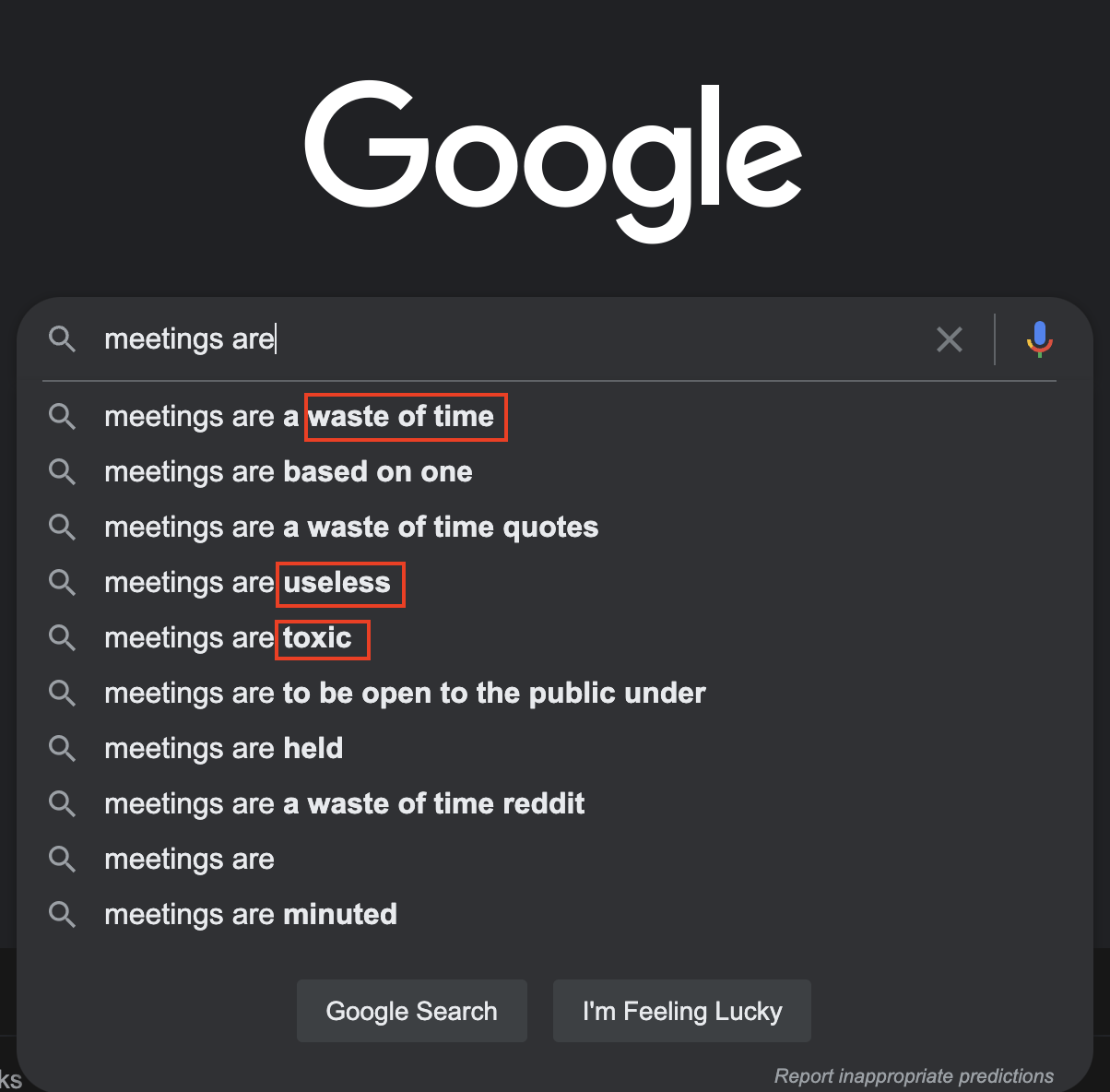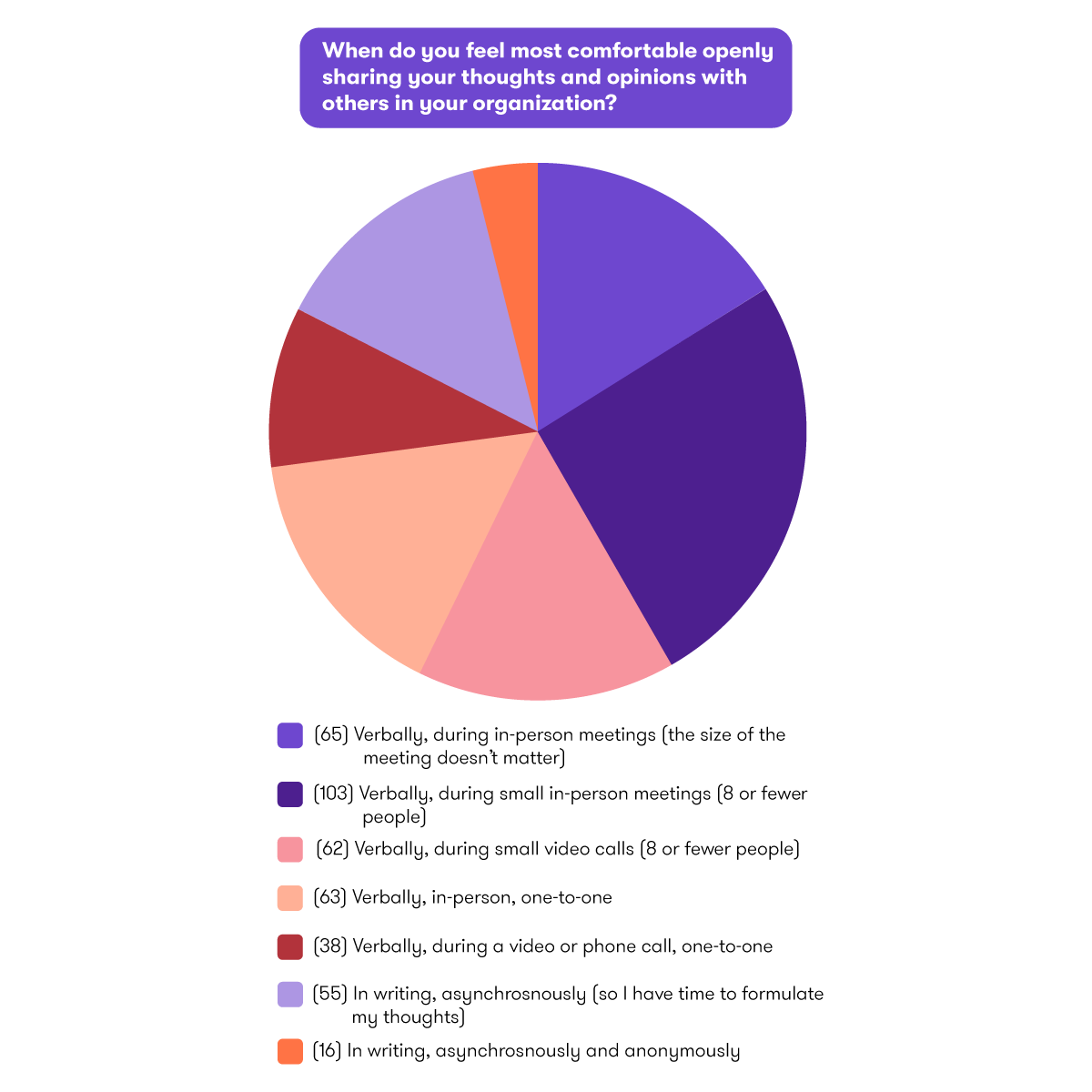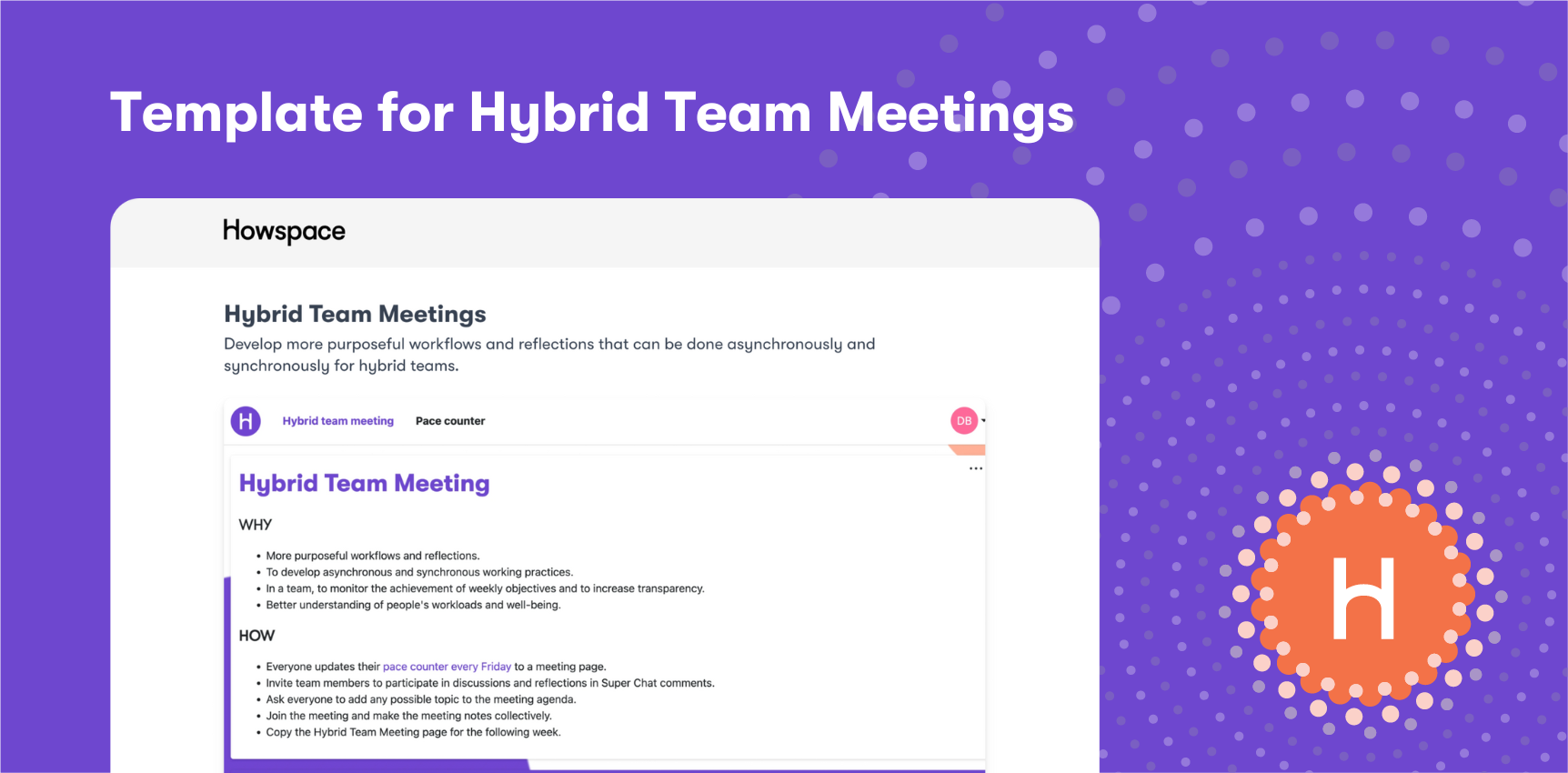
How to run an effective meeting: 10 simple tips
How many meetings did you attend today? Did all of the meetings have an agenda? Are you reading this now during a meeting?
Meetings don’t have the best reputation in the corporate world. A quick look at the top Google search results for “meetings are” makes that clear.

While meetings are needed for coordination from time to time, they’re playing too big a role with the rise of hybrid work. In fact, feeling overwhelmed with more meetings and messages was a top challenge of hybrid work, according to a Howspace global hybrid work survey.
If you want to improve your meeting culture and and learn how to run more effective meetings, it might be time for a change in how you approach meetings. Improving your organization’s meeting culture is one of the most effective ways to develop your organization.
Grab our free template for hybrid meetings and get inspiration for your next hybrid meeting.
What makes an effective meeting?
An effective meeting brings a specific group of people together for a specific purpose, and moves a decision or a plan forward. People feel free to discuss openly and by the end of the meeting, they understand what’s expected of them and what comes next.
An ineffective meeting doesn’t have a purpose or agenda, lasts far too long, and results in wasted time and reduced energy for the people involved.
Meetings are best suited for making decisions and ensuring that everything is going in the right direction. They shouldn’t interrupt you and your employee’s work, but rather they should enable you to move your work forward.
To sum it up, effective meetings:
✅ Have a clear purpose and agenda
✅ Include only the relevant people
✅ Enable open discussion
✅ Result in a decision made or a plan to follow
✅ Bring clarity to the next steps ahead
The cost of ineffective meetings
Meetings are likely costing companies more money than they realize. To get a sense of these costs, calculate each meeting attendee’s hourly rate, multiply that by the length of the meeting, then tally up all the attendees’ costs together. But that’s just the tip of the iceberg: people also need to prepare for meetings, and meetings add a context-switching cost.
On average, middle managers spend around 50% of their time in meetings, and senior managers spend up to 80% of their time at meetings. The more managers or knowledge employees your company has, the more time is spent in meetings. These expenses are hidden but very real.
How can you make your meetings more effective?
You know what an effective meeting looks like, but how can you make that your reality?
We asked CEO of Better Meetings, Wenche Strømsnes, to share her tips on how to run effective meetings. With over 20 years of experience in leadership and organizational development, Wenche now focuses on helping companies improve their meeting culture.
These are our best practices for better meetings, inspired by our discussion with Wenche.
1. Have a clear purpose for the meeting
Before sending out those calendar invitations, think twice about whether the meeting is necessary. Ask yourself: What’s my goal, and how can I best accomplish this goal? Is the purpose to make a decision, sensemaking, or creative work?
While booking a meeting is often the default choice to discuss things together as a group, it’s not necessarily the best solution. If you have a great deal of information you want to share, or want to share a status update, can you consider communicating asynchronously instead?
2. Create a meeting agenda
A meeting without an agenda is rarely productive. The atmosphere may seem creative and inspiring, but the discussion is all over the place, and the meeting may end in confusion or poor decisions.
Having an agenda ensures that everyone is on the same page and can prepare for the meeting. Participants will know the reason why they’re present and what they’re trying to achieve. You can set the context and agenda well beforehand, and ask participants to do some pre-work to tune into the topic.
3. Keep the agenda simple
This tip especially applies to virtual meetings, which have been the default for most companies since the pandemic. Without the need to travel to each meeting, it can be tempting to fill up calendars with back-to-back meetings. But this will only lead to reduced motivation and burnout.
When booking a virtual meeting, stick to a few simple agenda points. By doing so, it’s easier to book shorter meetings and give people time to breathe and reset before going into the next meeting. Instead of booking a full hour, try to book meetings for 45 minutes or less. When looking at your colleagues’ schedules, try to leave 10-15 minutes for a break between meetings.
4. Reduce the number of meetings at your company
Half of all meetings are considered a waste of time, according to research by Professor Steven Rogelberg. As Rogelberg states, having a 50% return when there are 55 million meetings a day is pretty concerning.
The solution is simple: Consider reducing the number of meetings at your company. Reduced conference calls is a growing trend, as such calls have often been seen as intrusive with the rise of remote work. We need to learn new ways of working where not all working hours are spent in back-to-back meetings and the ‘real work’ is done on weekends and evenings.
Pay attention to the quality of each meeting. This enables you to see what types of meetings can be cut or moved asynchronously, so everyone in the company can use their valuable time productively.
5. Embrace different opinions
Research shows that decisions made under conflict are actually better, as people will feel more committed to such decisions, even when they did not get their point through.
As a leader, you can create conflict by facilitating productive debate and acknowledging different views. Be clear that you want different perspectives: ask for different views, challenge the participants, or ask people to talk in pairs. Be aware of who you give the floor to first. Steering the conversation will lead to proper discussion.
Psst! If you’d like to experience how a simple platform can help make everyone’s voice heard as well as make meetings more efficient and inclusive, start Howspace for free today.
6. Take responsibility to improve the meeting culture
Even if you’re not the meeting organizer, you can improve the quality of a meeting. If you don’t receive the agenda for the meeting, ask for one. By understanding the goal of the discussion, you’ll be able to prepare and make sure that you’re able to give 100%. And if you don’t think your time will be best spent in a live meeting, you can always offer to work on something asynchronously, but skip the synchronous discussion.
It’s tempting to multitask during meetings—respond to that Slack message, check LinkedIn, or work on some other task—but this will just lead to a feeling of overwhelm. If you’re attending a meeting, aim to be fully present.
We recommend checking out the book Death by Meeting, a bestseller by Patrick Lencioni, which includes practical tips for improving the quality of meetings.
7. Create safe spaces for discussion
For many people, discussion is a way of processing thoughts. Organizations need forums where people can freely share their thoughts. Meetings are often used for this type of discussion, but it’s not the only way to hear people’s thoughts and opinions. You can also invite people to share in writing, and create opportunities to share anonymously.
Not every person feels comfortable sharing their thoughts out loud or in meetings. In fact, people’s preferences for sharing their opinions with others varies quite a bit, according to the Howspace survey results.

8. Make the most of technology
You can become more efficient and structured by digitizing good meeting habits. While in-person meetings have their purpose, virtual, and asynchronous communication opens up new opportunities for involving people.
With the right tools and technology, you can include more people than you would be able to for face-to-face meetings and workshops. With Howspace, for example, you could involve a limitless number of people in development processes, regardless of time zone and location.
9. Don’t make ad-hoc meetings a habit
You can measure your company’s meeting culture by the number of ad-hoc meetings people attend. Ad-hoc meetings—one-off, impromptu meetings—should take up no more than 5% of your time. If you frequently need to organize meetings on short notice, your meeting culture might be ineffective.
Ad-hoc meetings are usually for coordination. So needing many ad-hoc meetings means that your company has an unhealthy need for coordination. Maybe this need could be eliminated by giving people more power to make decisions?
Of course, surprises come up, and certain important topics might require quick attention. But ideally, employees should spend most of their time working on non-urgent and important tasks. This means they will feel less rushed, more goal-oriented, and more balanced—which will lead to better results for the company.
10. Have no more than eight people at a meeting
When choosing who to invite to a meeting, think about the actual impact. Who do you need to have at the meeting in order to make decisions? Do you know someone who is opposed to the issue? Include them as well.
Based on her experience, Wenche recommends having no more than eight people at a meeting to ensure it’s efficient. You can have more only if you plan the meeting well and work in smaller groups.
Check out our template for hybrid meetings! This template will help you create more collaborative team practices that work for everyone, no matter where they’re working from.
Already a Howspace-user? You can add the template to your account here.

You might be interested in these as well
View all
The future of learning: How to design learning experiences for the hybrid world
It’s no secret: work as we know it has changed for good. COVID-19, the Great Resignation, and the rise of […]

The future of work is more than hybrid: How to build a community-centric culture
Hybrid work has been a hot topic since the pandemic. Companies learned that work can get done even if employees […]

Find out which of these 3 hybrid work models is best for your organization
This preference for hybrid work is bringing most organizations face-to-face with a pressing question: which hybrid work model is best for your company?